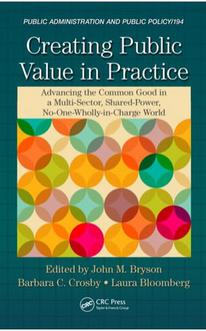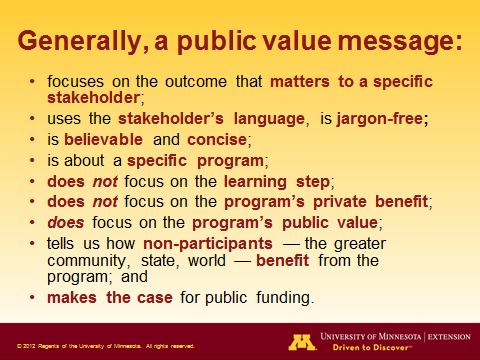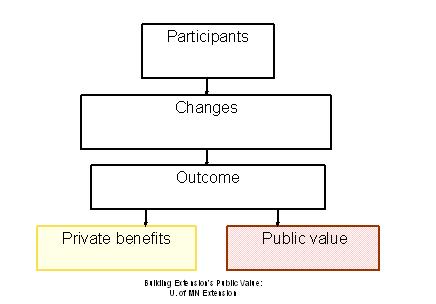Public Value messages
How do your programs create public value?
In the Building Extension’s Public Value workshop, we highlight three main ways Extension programs create public value. Programs address concerns about fairness, close an information gap, or encourage actions that benefit the greater community (or equivalently, discourage actions that impose costs on the community). Each of these can be thought of as a criterion or justification for public sector involvement. In my experience, most Extension programs focus on the third type of value creation and base their public value message on the ways a program encourages beneficial activities.
We can’t generalize from this non-scientific poll, but I wondered about the lack of attention to the fairness criterion. In the workshop, I encourage program teams to use this criterion with caution. Whether the unfairness of a situation warrants public sector action is subjective, and stakeholders with different values may assess fairness differently. So, I think Extension makes a more effective case when it uses the fairness criterion selectively. For this reason, I wasn’t surprised by the small number of responses for fairness. I wondered, though, whether it arose because respondents thought their programs did not address a concern about fairness, or if they thought the program did address fairness, but they planned to emphasize a different criterion in order to make a stronger case.
Do you think a relatively small share of Extension programs address a fairness concern? Which criterion would you have chosen for the Extension programs you work with?
The post How do your programs create public value? appeared first on Building Extension's Public Value.
The private-public benefit intersection
I don’t typically emphasize this intersection, because the objective of the public value works is to adopt the perspective of the non-participant payers of Extension programs–the community-members who are being asked to share in the cost of the programs through public funding, but who do not receive the private benefits of program participation. Nevertheless, the point that an intersection between public and private benefits exists, is well-taken.
Working Differently in Extension Podcast
Interested in a short introduction to “Building Extension’s Public Value”? Check out this Working Differently in Extension Podcast, featuring a conversation between Bob Bertsch of Agricultural Communication at North Dakota State University and me. If you’d like to actually see us converse, check out the video of the podcast below.
Telling 4-H’s public value story
Nancy Franz of Iowa State University Extension has alerted me (and the rest of the her Public Value Network listserv) to the California 4-H program’s involvement of volunteers and staff in a statewide effort to develop public value stories. On the program’s California Public Values web page, a survey link invites volunteers and staff to participate in the effort to “shape California 4-H’s public values that will be shared with the broader community that has a stake in 4-H.”
The survey asks respondents to identify (1) positive benefits to youth from participating in 4-H, (2) ways society benefits from those positive youth outcomes, and (3) community or state benefits from adult volunteer participation in the 4-H program.
“Crowdsourcing”–at least from select sources, such as those working with 4H across the state–sounds like a potentially efficient way to assemble a body of program impact stories. Local program staff can bring to administrators’ and evaluators’ attention impacts that might otherwise have been overlooked. I am eager to hear how the California 4H public value project develops.
National resources for impacts and public value
First, I think it was NIFA director Dr. Sonny Ramaswamy who mentioned an effort this summer to develop a national portal for impact reporting that will consolidate Extension program impact results.
Second, I believe it was ECOP chair Dr. Daryl Buchholz who highlighted ECOP’s Measuring Excellence initiative. It appears that this project is meant to define and demonstrate excellence and to report impacts for Cooperative Extension as a whole. From the website: “Cooperative Extension has advanced from merely reporting inputs and outputs to documenting outcomes and impacts of its programs. However, most of these measures are tied to specific programs. They are not generally assessed or considered at the organizational level.” While the “excellence” part of the website is well-developed, the pages having to do with impact are still under construction. I look forward to the work that will populate these pages with resources and guidance for Extension impact teams. Meanwhile, I have to give a shout out for the public value statements on the front page of the website!
By the way, my notes from the PILD keynote talks are a little sparse. If I am wrong about which speaker spoke about which initiative, please correct me in the comments. And if you know more about how the portal or the Measuring Excellence project can strengthen Extension’s public value case, please share that, too!
(Photo credit: USDAgov on FlickR)
Do people’s eyes glaze over when you talk about your Extension program?

In the video, McCormack offers tips for constructing an effective pitch: make the pitch “short, simple, clear, articulate, informative, engaging, even entertaining.” All of those adjectives could apply to an effective public value message for an Extension program, with a few more suggestions shown in the slide below
#sciencepitch? How about #Extensionpitch?
Earlier this year the California Institute for Regenerative Medicine (CIRM) held what they called an Elevator Pitch Challenge. The goal of the challenge was to help researchers who get funding from the stem cell agency do a better job of communicating with the public. They invited any researcher who gets CIRM funding to prepare a 30 second videotaped pitch, keeping it short, simple and something anyone can understand. CIRM staff then voted who they thought did the best job.
The resulting videos are posted on the CIRM website and on Youtube under the hashtag #sciencepitch.As CIRM’s press release says, “We are a publicly funded agency and the money we use to fund research comes from the people of California, so it’s only reasonable to expect researchers to be able to explain the importance of what they do to Californians, and anyone else they might meet.”
Sound familiar? This is the same challenge the public value approach presents to Extension programs: Explain to people with no connection to your program why they should fund it. I haven’t seen any public value messages on video, but there’s no reason it couldn’t be done. Has your organization asked Extension programs to record a public value “pitch”? Should we give it a try? If we assembled a series of videotaped messages, what would be the most effective use of them? Maybe we can start an #Extensionpitch Youtube channel to share our efforts and spark ideas of how to use the videos.
Less obesity, lower costs?
Today in her blog, “Food Politics,” Marion Nestle summarizes some recent estimates from the Campaign to End Obesity of the cost of obesity in the United States. Nestle sounds reluctant to take the estimates at face value, but admits, “One thing is clear: obesity is expensive, personally, economically, and politically.”
Extension programs of many types aim to reduce the incidence of and costs associated with obesity. Not only nutrition education programs, but some agriculture programs (farmers markets, local foods), youth programs, and even community leadership programs seek to improve health and impact the obesity problem. And to be effective with non-participant stakeholders–to demonstrate public value–these programs would like to report the dollar value of savings they have helped generate for state and local governments and for communities. Can estimates such those released by the Campaign to End Obesity help Extension programs make their case?Do you work with programs that address obesity and its impact on communities? Have you found estimates of the cost of obesity that can be used to support your program’s public value? Do you focus on public health costs–which affect all community members–or have you found a way to incorporate even the impact on private health care costs into a public value message?
Constructing a public value message in real time
We included a blank version of the public value message graphic, like the one below, except with empty boxes. Prior to the session, we asked Sue Letourneau, program leader for health and nutrition programs, to share a public value message for Extension’s Simply Good Eating program. I created a slide that included Sue’s text within the message graphic and added animation that brought the text in one box at a time. At the session, I asked Sue to present her message, explaining how her team arrived at the language they chose.
Given the short amount of time, we hope this approach helped participants see how a program team can go about constructing a public value message, even if they didn’t get a chance to do so themselves. It also gave an example of a UM Extension program that had completed the workshop, hopefully dispelling concerns that it would be too demanding. Finally, Sue helped participants see how the public value message was related to the research agenda that the Simply Good Eating program team is currently implementing.










